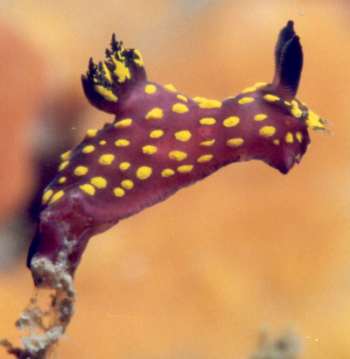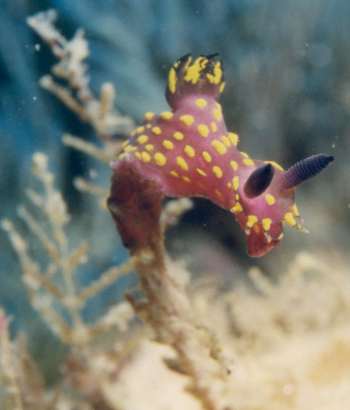Polycera janjukia from Port Stephens, NSW
January 14, 2006
From: Leanne & David Atkinson

Dear Bill,
David found this spectacular little creature recently. We have never seen it at Port Stephens before. It was rearing up tasting the water and was not at all interested in the Blue/green Bugula dentata behind the plant that it was on. We tried putting it on the Bugula dentata because it seemed to be a Polycera and Polycera capensis is often found on this Bugula dentata but it wasn't interested and crawled back to the brown plant that looks like the one we usually find Flabellina rubrolineata on. It then continued its behaviour of rearing up and tasting the current. We've identified it as Polycera janjukia from the Sea Slug forum and noticed you'd replied to Nerida Wilson that you thought Bugula dentata might be a food source for it. Does Bugula dentata change colour as part of its life cycle or does it have different colour forms? Our Blue/green one seems to loose colour and "die back" at different times of the year. The water was a comfortable 20 degrees celcius on this dive.
Locality: Twin Bombies, Halifax Sponge Gardens, Port Stephens, NSW Australia. Depth: 18 metres. Length: 5 mm. 06 January 2006. Sponge Gardens. Photographer: Leanne & David Atkinson
Regards,
Leanne & David Atkinson
atk@hunterlink.net.au
Atkinson, L. & D., 2006 (Jan 14) Polycera janjukia from Port Stephens, NSW. [Message in] Sea Slug Forum. Australian Museum, Sydney. Available from http://www.seaslugforum.net/find/15550
Dear Leanne & David,
This is a spectacularly coloured species, if on the small side. I think the 'might' should be emphasised in my thought that Bugula might be the food of this species. It certainly worth testing it on Bugula, but finding the food of these animals is often difficult. I don't think Bugula changes colour so I think your description of 'die back' is probably correct with the colony dying back or being partly eaten by something and then growing back. I am also pretty sure the 'plant' your animal is photographed on is the remains of a hydroid colony, only the central stalk and few short branches remaining. Hydroid colonies often loo like this after a visit from Flabellina rubrolineata or some other voracious hydroid feeder.
Best wishes,
Bill Rudman
Related messages
-
Polycera janjukia from Tasmania
From: Nerida Wilson, April 18, 2000
